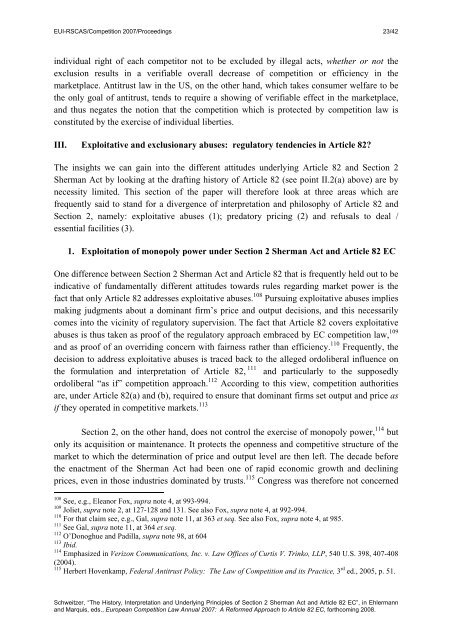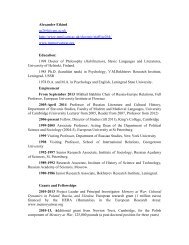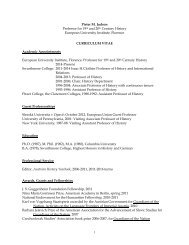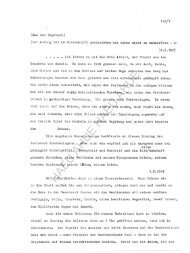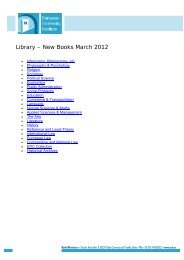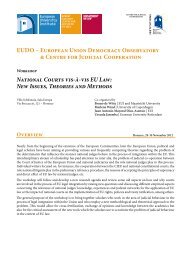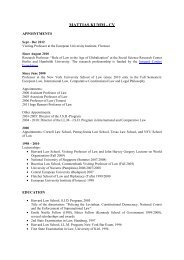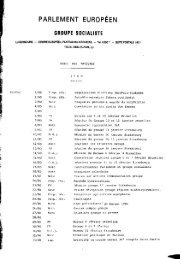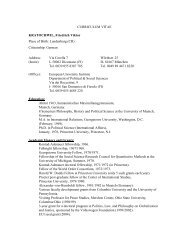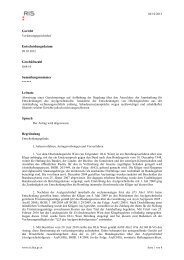The History, Interpretation and Underlying Principles of Section
The History, Interpretation and Underlying Principles of Section
The History, Interpretation and Underlying Principles of Section
You also want an ePaper? Increase the reach of your titles
YUMPU automatically turns print PDFs into web optimized ePapers that Google loves.
EUI-RSCAS/Competition 2007/Proceedings 23/42<br />
individual right <strong>of</strong> each competitor not to be excluded by illegal acts, whether or not the<br />
exclusion results in a verifiable overall decrease <strong>of</strong> competition or efficiency in the<br />
marketplace. Antitrust law in the US, on the other h<strong>and</strong>, which takes consumer welfare to be<br />
the only goal <strong>of</strong> antitrust, tends to require a showing <strong>of</strong> verifiable effect in the marketplace,<br />
<strong>and</strong> thus negates the notion that the competition which is protected by competition law is<br />
constituted by the exercise <strong>of</strong> individual liberties.<br />
III. Exploitative <strong>and</strong> exclusionary abuses: regulatory tendencies in Article 82?<br />
<strong>The</strong> insights we can gain into the different attitudes underlying Article 82 <strong>and</strong> <strong>Section</strong> 2<br />
Sherman Act by looking at the drafting history <strong>of</strong> Article 82 (see point II.2(a) above) are by<br />
necessity limited. This section <strong>of</strong> the paper will therefore look at three areas which are<br />
frequently said to st<strong>and</strong> for a divergence <strong>of</strong> interpretation <strong>and</strong> philosophy <strong>of</strong> Article 82 <strong>and</strong><br />
<strong>Section</strong> 2, namely: exploitative abuses (1); predatory pricing (2) <strong>and</strong> refusals to deal /<br />
essential facilities (3).<br />
1. Exploitation <strong>of</strong> monopoly power under <strong>Section</strong> 2 Sherman Act <strong>and</strong> Article 82 EC<br />
One difference between <strong>Section</strong> 2 Sherman Act <strong>and</strong> Article 82 that is frequently held out to be<br />
indicative <strong>of</strong> fundamentally different attitudes towards rules regarding market power is the<br />
fact that only Article 82 addresses exploitative abuses. 108 Pursuing exploitative abuses implies<br />
making judgments about a dominant firm’s price <strong>and</strong> output decisions, <strong>and</strong> this necessarily<br />
comes into the vicinity <strong>of</strong> regulatory supervision. <strong>The</strong> fact that Article 82 covers exploitative<br />
abuses is thus taken as pro<strong>of</strong> <strong>of</strong> the regulatory approach embraced by EC competition law, 109<br />
<strong>and</strong> as pro<strong>of</strong> <strong>of</strong> an overriding concern with fairness rather than efficiency. 110 Frequently, the<br />
decision to address exploitative abuses is traced back to the alleged ordoliberal influence on<br />
the formulation <strong>and</strong> interpretation <strong>of</strong> Article 82, 111 <strong>and</strong> particularly to the supposedly<br />
ordoliberal “as if” competition approach. 112 According to this view, competition authorities<br />
are, under Article 82(a) <strong>and</strong> (b), required to ensure that dominant firms set output <strong>and</strong> price as<br />
if they operated in competitive markets. 113<br />
<strong>Section</strong> 2, on the other h<strong>and</strong>, does not control the exercise <strong>of</strong> monopoly power, 114 but<br />
only its acquisition or maintenance. It protects the openness <strong>and</strong> competitive structure <strong>of</strong> the<br />
market to which the determination <strong>of</strong> price <strong>and</strong> output level are then left. <strong>The</strong> decade before<br />
the enactment <strong>of</strong> the Sherman Act had been one <strong>of</strong> rapid economic growth <strong>and</strong> declining<br />
prices, even in those industries dominated by trusts. 115 Congress was therefore not concerned<br />
108<br />
See, e.g., Eleanor Fox, supra note 4, at 993-994.<br />
109<br />
Joliet, supra note 2, at 127-128 <strong>and</strong> 131. See also Fox, supra note 4, at 992-994.<br />
110<br />
For that claim see, e.g., Gal, supra note 11, at 363 et seq. See also Fox, supra note 4, at 985.<br />
111<br />
See Gal, supra note 11, at 364 et seq.<br />
112<br />
O’Donoghue <strong>and</strong> Padilla, supra note 98, at 604<br />
113<br />
Ibid.<br />
114<br />
Emphasized in Verizon Communications, Inc. v. Law Offices <strong>of</strong> Curtis V. Trinko, LLP, 540 U.S. 398, 407-408<br />
(2004).<br />
115 rd<br />
Herbert Hovenkamp, Federal Antitrust Policy: <strong>The</strong> Law <strong>of</strong> Competition <strong>and</strong> its Practice, 3 ed., 2005, p. 51.<br />
Schweitzer, “<strong>The</strong> <strong>History</strong>, <strong>Interpretation</strong> <strong>and</strong> <strong>Underlying</strong> <strong>Principles</strong> <strong>of</strong> <strong>Section</strong> 2 Sherman Act <strong>and</strong> Article 82 EC”, in Ehlermann<br />
<strong>and</strong> Marquis, eds., European Competition Law Annual 2007: A Reformed Approach to Article 82 EC, forthcoming 2008.


